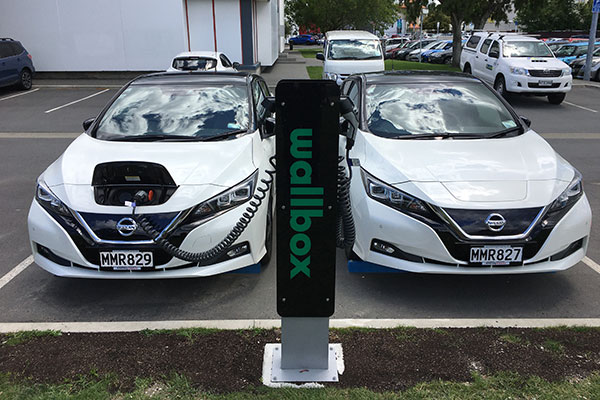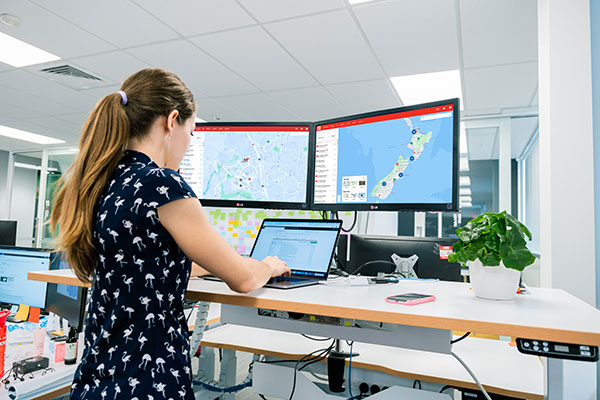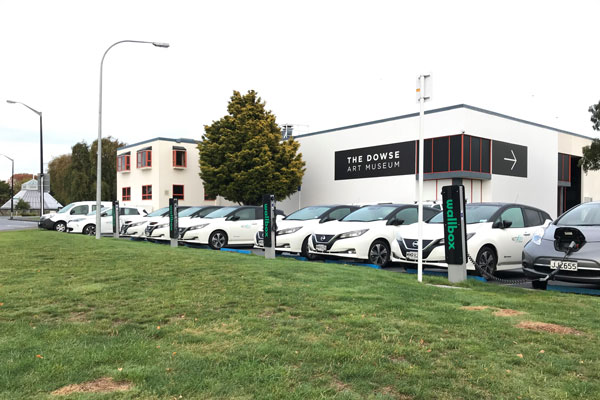Lowering Emissions in Lower Hutt
Lowering Emissions in Lower Hutt
Hutt City Council’s fleet electrification has been three years in the making. If you’re looking to swiftly transition to EVs, lessons learned from their journey can help your organisation get up to speed.
Head of Climate and Waste at Hutt Valley Council, Jörn Scherzer drives internal initiatives around solid waste and carbon reduction. His mandate is to improve council efficiency and advise teams on what they can do to lower their carbon output, from phasing out natural gas to electrifying their fleets.
When Jörn joined the council three and a half years ago, carbon was much less of a concern than cost. He realised early on that getting the green outcomes he desired would require convincing decision makers of the potential savings. Though the council already had EROAD and a fleet administrator, they used telematics mainly for vehicle tracking and health and safety but didn’t do much with the data.
Once they hired consultants to perform a fleet utilisation analysis in 2018, however, that EROAD data really came into its own. It could tell them things like how far each vehicle had travelled, how much of the time they were parked up, and of any functional overlap between departments or across locations. Because of his background at EECA, where he had worked for six years prior, Jörn could see that the council’s fleet was “pretty inefficient” straight away: “You’d just have to walk toward the car park and you’d find a lot of cars parked up during the day.”
Fleet Audit Highlights Inefficiencies
At the time, 85% of the fleet was leased from five different companies, and an analysis by lifecycle consultant OptiFleet suggested that moving to purchasing would yield cost efficiencies. All government agencies can access exceptionally good vehicle pricing, and the purchasing process is much simpler than the leasing process, especially when you factor in lease extensions and the administration required.
Based on the following recommendations, the Optifleet audit identified potential savings of $400K over three years. Cost savings were then used to offset the cost of buying EVs. Now, 25% of the council’s fleet is EVs, with more to come once suitable vehicle types become available on the market.
Contractor Emissions a Key Concern
All government agencies are also tasked with aiming for carbon neutrality by 2050. After removing 13 fleet vehicles and increasing EV uptake – the low-hanging fruit – the council turned its attention to its contractors.
“Emissions from the service providers we contract are actually part of our carbon footprint: vehicles servicing public litter bins, maintaining streetlights, and the whole range of services councils provide,” says Jörn. “Contractor emissions are more complex because it’s not something we necessarily control directly, but we do it through procurement.”
Seeking to reward companies for going green, Hutt Valley Council assigned “bonus points” to bidding contractors with electric vehicles. “If you just talk about it but don’t assign any weight to it in your tender documentation, you’re not going to get what you’re asking for.”
The council acknowledged the possibility that suppliers with diesel trucks might vastly undercut more sustainable providers on price. “We were well prepared to pay more, but as it turns out, our preferred supplier was not only cost-effective but also offered to go fully electric by 2024, so we basically got the best of both!”
Currently, about half of the council’s rubbish and recycling contracts are with companies that use electric trucks, and they aim to go fully electric by 2024. As of July 2021, they have 11 electric rubbish trucks in service – a priority initiative because waste collection vehicles run practically all day. But putting sustainability into play takes a lot of behind-the-scenes work.

Knowing Is Only Half the Battle
It’s one thing to want to make changes but another to actually make them happen. “It takes massive organisational change to get a new service rolled out, so any carbon reduction initiatives or objectives you want to achieve need to be built in right from the get-go.”
While the technology for waste management is already there, other sectors are still emerging, so make sure you allow bidding contractors adequate time to prepare. Jörn recommends notifying them a year out. But bear in mind that having a procurement policy is only part of the equation. “You still need champions within the organisation to actually implement it.”
The same can be said of telematics data: “You can track it, but unless you have someone who actually analyses the data and uses it to say, ‘Okay, we need to improve,’ then it’s just data you collect for no particular reason.”
The fleet administrator they had was only part-time and generally provided transactional information like quotes rather than input on the advisability of a given vehicle. “That’s something I do now, look at what they actually need. As a result of the OptiFleet review, we moved to purchasing and now have a centralised fleet budget and about 10 vehicles in a centralised pool.”
Jörn says you can still do the same amount of travel, just with fewer vehicles. Because so many fleets are inefficient, in most cases, a reduction of 20 to 25% has no impact on vehicle availability or operational capacity. “Because you’re pooling vehicles, you’re not buying as many and you can invest some of the savings in EVs.”
While moving to purchasing was easy and immediate, pooling vehicles and reviewing take-home policies took two years because their CEO at the time didn’t buy into the report’s recommendations. In some cases, employees accustomed to taking vehicles home saw it as their right, even though it wasn’t part of their contract, and were reluctant to relinquish their vehicles.
Eventually, a new CEO, changes at the leadership level, and an increased global focus on carbon output gave them the impetus they needed to add EVs and address some of their efficiencies. “If we hadn’t had that leadership, I don’t think this would have gone anywhere.”

How HCC Managed Organisational Change
Relationship management and engaging stakeholders is absolutely crucial. “To do that, you need to be proactive and look at opportunities. You need internal champions to think of these things, enact them, and then take them to those stakeholders.”
The change management process required a formal HR proposal and consultation period where stakeholders could provide feedback on the proposed changes. After taking that feedback on board and making some adjustments, the plan was announced by the CEO with the buy-in of the whole management team.
Well ahead of the rollout, they communicated to staff that EVs were coming and what people would be expected to do, including plugging in after returning from every trip, regardless of battery status. “At the moment we can do that because we’ve got enough charging stations. It eliminates the doubt factor.”
The vehicles the council prioritised for electrification were pool cars. “We’ve rolled out charging stations here at the council, so they just charge up overnight.” They also developed a guide to be kept in pool vehicles for people to refer to, particularly since pool drivers may use vehicles only sporadically. With that in mind, policies were designed to be clear and easy to remember: “If you come back, you plug in. It’s that simple. Rather than plug in because it’s at 80% or less, which is a bit more complicated, especially for drivers who don’t use the car very often.”
The more difficult vehicles to replace were the take-home vehicles, particularly four-wheel drives, because there aren’t many fully electric models on the market. The council is currently trialling the Mitsubishi Outlander and MG5 station wagons for staff designated take-home vehicles. “Previously, every vehicle was taken home and now it’s about 50-50; half of the vehicles are assigned. We’ve also realised additional savings because we avoid a lot of fringe benefit tax.”
Because there are upfront costs – a smart charger costs $1000 to $3000 to install – “we have to balance practicality with being too pure. We wouldn’t have enough capacity to have all the vehicles charge at the council’s base all the time, so it makes sense to have chargers at home. We’ve verified that there’s a reason why the employee has a vehicle, so they need to be able to charge up.”
They also have three bikes, two of which are electric, and are developing an internal carbon reduction plan across the council. “How can we further reduce emissions associated with staff travel? How do we get more people using public transport or a bike or scooter? We want to look at that over the next 12 months because we’re short on trucks.”
In the space of a week, Hutt Valley Council went from 2% EVs to 21% and the fleet will be 25% electric by mid-July. “I think is well ahead of what is happening in the Wellington region. It’s taken the new leadership team actually looking into the utilisation report and leading the culture and engaging people across the business to get this done.”



